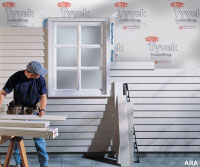 With energy costs expected to rise, builders are turning to insulated siding as yet another way to meet the needs of the environmentally-friendly — and cost-conscious — consumer. While few homeowners are aware that insulated siding can reduce consumption by up to 20 percent, they do know that replacing doors and windows enhances a property’s energy savings potential and its corresponding return on investment. The trick for builders is to create homeowner awareness to the positive impact of insulated sliding.
With energy costs expected to rise, builders are turning to insulated siding as yet another way to meet the needs of the environmentally-friendly — and cost-conscious — consumer. While few homeowners are aware that insulated siding can reduce consumption by up to 20 percent, they do know that replacing doors and windows enhances a property’s energy savings potential and its corresponding return on investment. The trick for builders is to create homeowner awareness to the positive impact of insulated sliding.
‘People know about the four most common ways to insulate their home, by upgrading doors and windows, and sealing the roof and foundation. But the wood framing within their walls is a significant area that most people fail to address,’ said Pat Culpepper, President of Progressive Foam Technologies, Inc., inventor of insulated siding, who describes the product as the ‘fifth dimension of home energy savings.’ Up to 40 percent of energy is lost through the wood studs, which conduct heat and cold. That’s the fifth dimension of home energy savings.’
According to the Environmental Protection Agency’s ENERGY STAR program, the average American household spends more than $1,900 each year on energy bills. Insulated siding, precision cut and contoured to fill the gap between the siding and home, cuts energy costs, says Progressive Foam Technologies, by delivering an average system R-value* of 3.96, which is more than triple that of any other exterior cladding. In comparison, popular products like fiber cement, brick and manufactured stone veneer, built without insulation, has average R-values of 0.15 to 0.62.
‘Wall studs make up 25 percent of the wall surface of an average home and that’s like having one whole wall in your home that is not insulated,’ added Culpepper, whose firm is headquartered in Beach City (OH). ‘Each of those studs is a thermal bridge that allows warm or cool air, depending on the season, to pass right through the wall. Imagine the home energy savings if you closed that gap.’
By closing the gap, the return on investment ultimately pays off for many homeowners. According to the National Association of Home Builders (NAHB), 51 percent of recently surveyed home buyers said they were willing to invest $5,000-$10,999 in their homes if energy costs could be reduced by roughly $1,000 a year.
There’s more good news for builders and consumers. The Vinyl Siding Institute, Inc. (VSI) recently announced that it has certified more than 3,000 installers and updated its Vinyl Siding Installation Manual, the core content for the VSI Certified Installer Program which trains and tests experienced professionals on the proper installation techniques for vinyl siding.
‘Whether on new homes or residing projects, VSI Certified Installers have demonstrated their knowledge of the proper techniques for installing vinyl siding,’ said VSI President Jery Y. Huntley. ‘Just three years into the program, we’re proud to continue our commitment to quality installation with this updated manual and the growing availability of qualified installers and trainers.’
Builders, remodelers, contractors, architects, etc. can download an electronic version of the manual on VSI’s website at vinylsiding.org. Since the program was launched in 2005, VSI has certified 100 vinyl siding installation trainers to educate more than 3,000 Certified Installers. VSI Certified Installers must take a test and renew their certification every three years.
Insulated siding is available through a range of premium siding manufacturers including Alcoa Home Exteriors, Alside, CertainTeed, Crane Performance Siding, Heartland Building Products, Mitten Inc., Norandex/Reynolds, KP Building Products, Revere Building Products, RMC/Style Crest and Variform.
[Editor’s Note: *R-value is the recognized numerical measure of the ability of an insulation product to restrict the flow of heat and, therefore, to reduce energy costs.]Written by Peter L. Mosca for www.RealtyTimescom. Copyright
